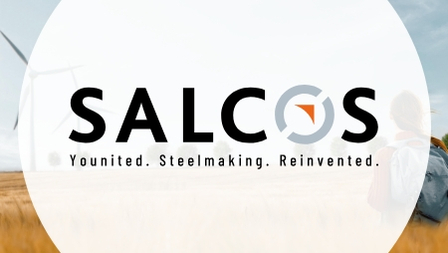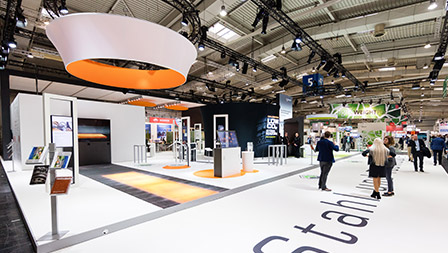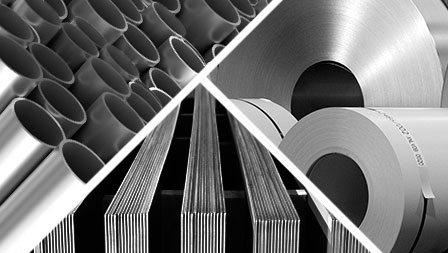GrInHy2.0: EU Funding Body Visits the World’s Largest High-Temperature Electrolyser of Salzgitter Flachstahl GmbH
14.07.2021 | Salzgitter AG
FCH JU Executive Director Meets the GrInHy2.0 Project Partners On-Site
The GrInHy2.0 high-temperature electrolyser, which has been successfully operated for the first time in 2020, is the world’s largest one installed in an industrial environment. On June 14, 2021, Bart Biebuyck, Executive Director of the EU funding body “Fuel Cells and Hydrogen Joint Undertaking” (FCH JU), visited the Salzgitter Flachstahl iron- and steelworks to learn more about the GrInHy2.0 electrolyser installation on-site and to get informed about the project status.
GrInHy2.0 started in 2019 as the succeeding project of GrInHy (“Green Industrial Hydrogen”). Utilizing green hydrogen, made from water steam and renewable electricity via high-temperature electrolysis, a CO2-emission-free steel production can be achieved in the long term. The project is setting the path towards decarbonizing the steel industry. Members of the consortium are Salzgitter Flachstahl (SZFG), Salzgitter Mannesmann Forschung, Sunfire, SMS Group company Paul Wurth, Tenova and the French research center CEA.
From the EU’s point of view, GrInHy2.0 contributes to the ambitious EU climate targets of a net-zero economy until 2050. The project lays the foundation towards the ramp-up of electrolysis technologies and thus green hydrogen production across Europe. “The ambitious GrinHy2.0 project demonstrates how green hydrogen can successfully decarbonize hard to electrify sectors such as steel production by utilizing the waste heat from high-temperature industrial processes. We are proud to see that European players are leading the way in high-temperate electrolysis (HTE) and to know that the FCH JU funding has enabled the demonstration of the world’s largest high-temperature electrolyser to date”, says Bart Biebuyck, Executive Director of the FCH JU.
The high-temperature electrolyser has been developed and constructed by the electrolysis company Sunfire. It is based on the innovative solid oxide electrolysis cell (SOEC) technology, which utilizes waste heat and runs at 850 °C. Therefore, the system is much more efficient than other electrolysis technologies on the market: Sunfire’s high-temperature electrolyser requires significantly less electricity to produce one kilogram of green hydrogen. “GrInHy2.0 is an important demonstration project for us since it proves our electrolysis technology in an industrial environment. Contributing our deep technological know-how to the consortium, we are making another step towards decarbonizing industries that are still largely dependent on fossil resources”, says Sunfire CEO Nils Aldag.
The GrInHy2.0 electrolyser is part of Salzgitter’s transformation project “SALCOS®“ (SAlzgitter Low CO2-Steelmaking). With the existing infrastructure on-site – including the availability of steam from waste heat, a hydrogen pipeline and sufficient electricity supply – the system was built within perfect conditions. The electrolyser produced green hydrogen for the first time in December 2020, accomplishing a significant work schedule milestone of the project. Since then, the hydrogen produced has been fed directly into the steel plant’s hydrogen grid. As of today, 15 tons of green hydrogen have already been used in SZFG's annealing processes and galvanizing plants for steel refinement. "The steel industry can make an enormous contribution to decarbonizing the industry sector. Key is the availability of green hydrogen. With GrInHy2.0, we are testing an innovative and energy-efficient approach in an industrial setting", says Gunnar Groebler, CEO of Salzgitter AG and Board Member of Hydrogen Europe.
At the end of this year, the project partners aim to achieve a nominal production rate of 200 Nm³ of hydrogen per hour. The system is expected to be in operation for at least 13,000 hours and to provide proof of plant availability in excess of 95 % until the end of 2022. Over this period, the electrolyser is required to produce a minimum of 100 tons of green hydrogen and to provide evidence of an electrical efficiency exceeding 84 %LHV.
Information about the GrInHy2.0 and SALCOS projects are available at
https://salcos.salzgitter-ag.com und https://www.green-industrial-hydrogen.com/

This project has received funding from the Fuel Cells and Hydrogen 2 Joint Undertaking (JU) under Grant Agreement No 826350. This Joint Undertaking receives support from the European Union’s Horizon 2020 Research and Innovation programme, Hydrogen Europe and Hydrogen Europe Research.
About Salzgitter
Salzgitter AG is one of Europe’s leading steel and technology groups – with external sales of around 9 billion euro, a workforce of over 25,000 and just under 160 national and international subsidiary and associate companies. It is comprised of the Rolled Steel, Plate/Sections, Mannesmann, Trading and Technology business units. Salzgitter Flachstahl GmbH is the largest subsidiary, producing a broad range of high-quality special and branded steels for demanding customer segments such as the automobile industry. Salzgitter Mannesmann Forschung GmbH is the central research unit supporting the steel activities of the Salzgitter Group.
Details of the Salzgitter Group are available online at www.salzgitter-ag.com.
About Sunfire
Founded in 2010, Sunfire GmbH is a global leader in the production of industrial electrolyzers based on alkaline and solid oxide (SOEC) technologies. With its electrolysis solutions, Sunfire is addressing a key challenge of today’s energy system: Providing renewable hydrogen and e-Fuels from renewable electricity, water, and CO2 as climate-neutral substitutes for fossil energy. Sunfire’s innovative and proven electrolysis technology enables the transformation of carbon-intensive industries that are currently dependent on fossil-based oil, gas, or coal. The company employs more than 250 people located in Germany, Norway, and Switzerland.
For further information please visit www.sunfire.de/en/
About Paul Wurth
Headquartered in Luxembourg since its creation in 1870, the Paul Wurth Group is an established technology provider for the global ironmaking industry. Paul Wurth is a leading market player for the design and construction of complete blast furnace and coke oven plants. Direct reduction plants, environmental protection solutions and recycling technologies complete Paul Wurth’s product portfolio. Presently, the company is focusing on the development of innovative solutions for leading the decarbonisation of the metals industry. With more than 1500 employees, Paul Wurth is active worldwide, operating entities and affiliated companies in the main iron and steelmaking regions of the world.
For further information, please visit www.paulwurth.com
About Tenova
Tenova, a Techint Group company, is a worldwide partner for innovative, reliable and sustainable solutions in metals and mining. Tenova, including its TAKRAF affiliates, leverages a workforce of over 2,500 forward-thinking professionals located in 19 countries across 5 continents, who design technologies and develop services that help companies reduce costs, save energy, limit environmental impact and improve working conditions.
For more information please visit: www.tenova.com
About CEA
The CEA is a French public research organization, working in four main areas: energy transition (nuclear and renewable), digital transformation for industry, future health technologies, defense and security. Based on an excellent fundamental research, with its 20,000 employees and its research centers with impressive infrastructures, the CEA is a major player in European research. Its Institute CEA-Liten, employing 1,000 people, is fully dedicated to the activities on new technologies for renewable energy and energy efficiency. It is involved in various national and EU research and demonstration projects related to high temperature electrolyzers and/or fuel cells (SOEC/SOFC) and their integration on the electric system in presence of large renewable energy sources.
Further information at www.liten.cea.fr
Über Fuel Cells and Hydrogen Joint Undertaking
About the Fuel Cells and Hydrogen Joint Undertaking The Fuel Cells and Hydrogen Joint Undertaking (FCH JU) is a Public Private Partnership in which the European industry, research, academia (represented by Hydrogen Europe and Hydrogen Europe Research) and the EU (represented by the European Commission) work together to accelerate the deployment of fuel cell and hydrogen technologies. The FCH JU supports a wide range of projects, which help to put the EU at the forefront of research and innovation, bring the benefits of the technology to the citizens and enhance industry competitiveness.
















